2023年河南省人教新目标(Go for it)版中考英语二轮专题复习:专项11 非谓语动词(27张ppt)
文档属性
| 名称 | 2023年河南省人教新目标(Go for it)版中考英语二轮专题复习:专项11 非谓语动词(27张ppt) |  | |
| 格式 | zip | ||
| 文件大小 | 147.1KB | ||
| 资源类型 | 教案 | ||
| 版本资源 | 人教新目标(Go for it)版 | ||
| 科目 | 英语 | ||
| 更新时间 | 2023-03-25 19:55:23 | ||
图片预览


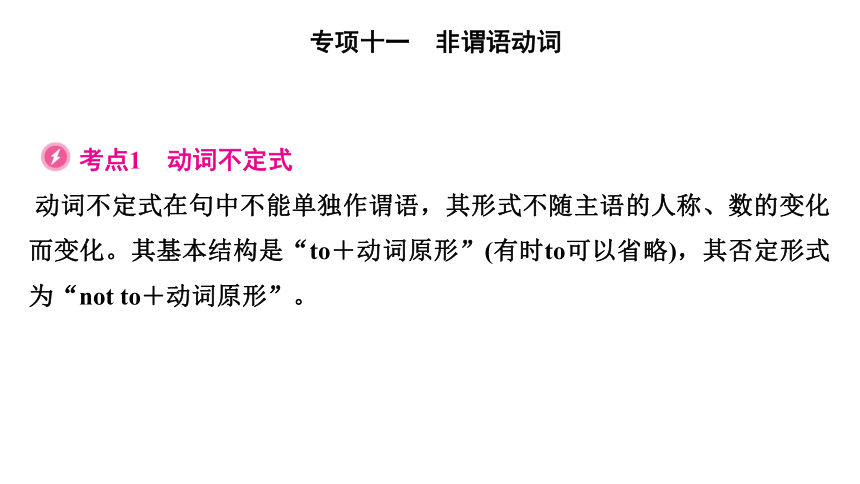

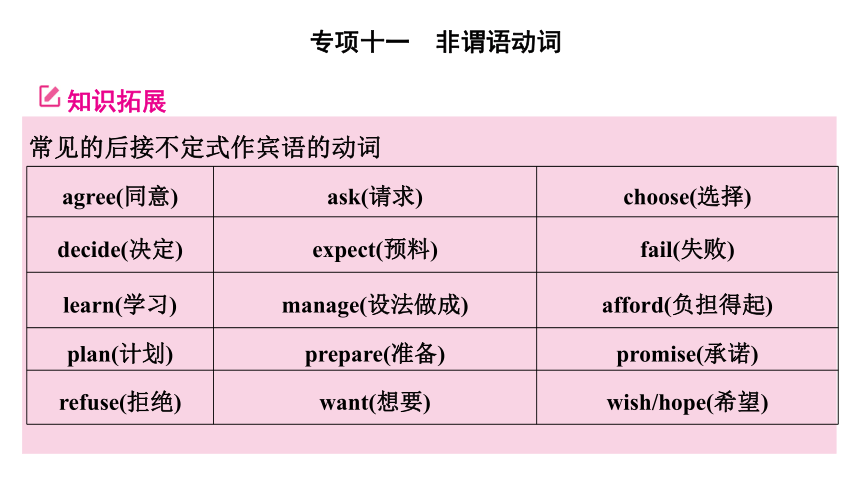
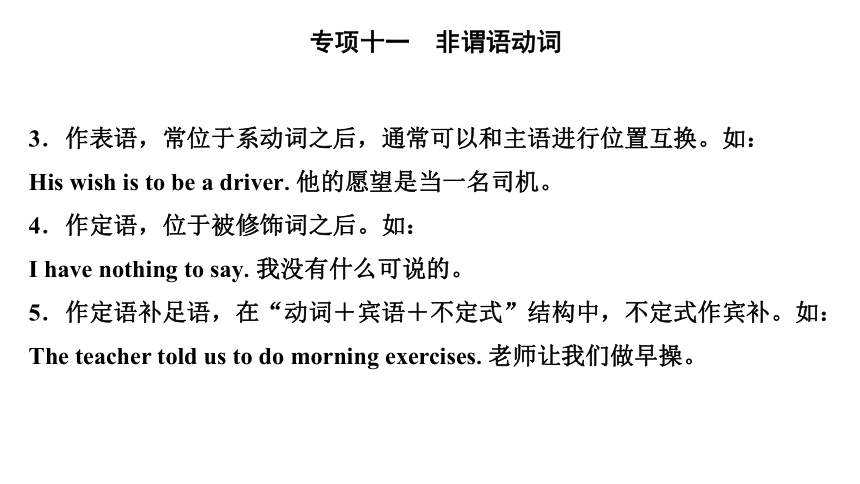
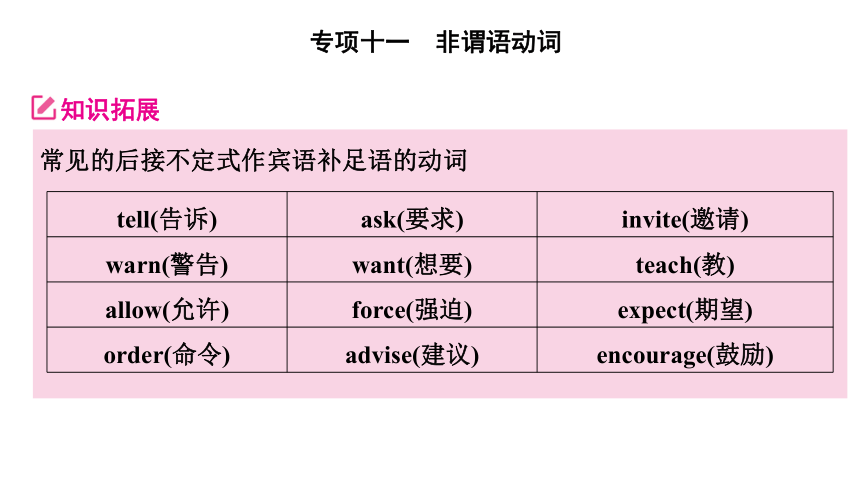
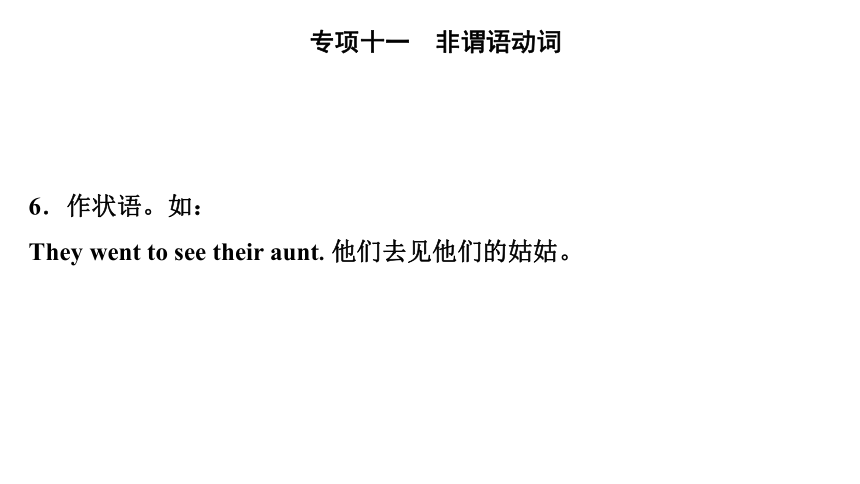
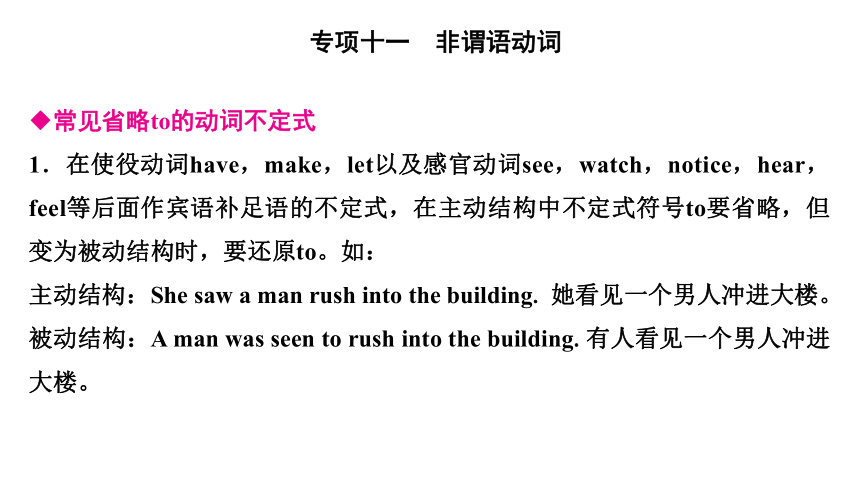
文档简介
(共27张PPT)
2021年河南中考中,语篇填空中共有2处对非谓语动词进行考查,1处对动词不定式进行考查,1处对动名词进行考查。2022年河南中考中,完形填空有1处对动词不定式进行考查,语篇填空中有2处对动词不定式进行考查。考生要熟记常见的可以跟动词不定式和动名词的动词和句型,并掌握动词不定式和动名词在句子中所作的成分。
考点1 动词不定式
动词不定式在句中不能单独作谓语,其形式不随主语的人称、数的变化而变化。其基本结构是“to+动词原形”(有时to可以省略),其否定形式为“not to+动词原形”。
◆动词不定式的用法
动词不定式具有名词、形容词和副词的特征,因此可以在句中作主语、表语、宾语、宾语补足语、定语和状语。
1.作主语,通常用it作形式主语,真正的不定式主语后置。如:
It's difficult to learn a foreign language.学习一门外语是很困难的。
2.作宾语。如:
Tom wanted to have a cup of beer.汤姆想要喝杯啤酒。
常见的后接不定式作宾语的动词
agree(同意) ask(请求) choose(选择)
decide(决定) expect(预料) fail(失败)
learn(学习) manage(设法做成) afford(负担得起)
plan(计划) prepare(准备) promise(承诺)
refuse(拒绝) want(想要) wish/hope(希望)
知识拓展
3.作表语,常位于系动词之后,通常可以和主语进行位置互换。如:
His wish is to be a driver.他的愿望是当一名司机。
4.作定语,位于被修饰词之后。如:
I have nothing to say.我没有什么可说的。
5.作定语补足语,在“动词+宾语+不定式”结构中,不定式作宾补。如:
The teacher told us to do morning exercises.老师让我们做早操。
知识拓展
常见的后接不定式作宾语补足语的动词
tell(告诉) ask(要求) invite(邀请)
warn(警告) want(想要) teach(教)
allow(允许) force(强迫) expect(期望)
order(命令) advise(建议) encourage(鼓励)
6.作状语。如:
They went to see their aunt.他们去见他们的姑姑。
◆常见省略to的动词不定式
1.在使役动词have,make,let以及感官动词see,watch,notice,hear,feel等后面作宾语补足语的不定式,在主动结构中不定式符号to要省略,但变为被动结构时,要还原to。如:
主动结构:She saw a man rush into the building. 她看见一个男人冲进大楼。
被动结构:A man was seen to rush into the building.有人看见一个男人冲进大楼。
2.当两个或多个作用相同的不定式并列时,通常只需第一个不定式用to,其余不定式的to可以省略。但是,如果两者有对比关系,则后面不定式的to不可省略。如:
(1)My mom told me to stay at home and wait for her.我妈妈叫我待在家里等她。
(2)To try and fail is better than not to try at all.尝试后失败总比不尝试好。
3.help后接不定式作宾语及宾语补足语时,to可省可不省。如:
The teacher often helps his students(to)deal with their problems in daily life.这位老师总是帮助他的学生应对生活中的问题。
巧记口诀
1.一感(feel)、二听(hear,listen to)、三让(let,make,have)、四看(look at,see,watch,notice),半帮助(help)
2.五看(see,watch,notice,observe,look at)、两听(hear,listen to)、三使(make,let,have)、一感觉(feel)
◆不定式常见的句型
1.had better(not)do sth.最好(不要)做某事,如:
You had better go to bed early.你(们)最好早点睡。
2.would rather do sth.宁愿做某事,如:
She would rather have some milk as breakfast. 她宁愿喝点牛奶当早餐。
3.prefer to do sth.rather than do sth.宁愿做某事而不愿做某事,如:
I prefer to stay at home rather than go shopping.我宁愿待在家里也不想出去逛街。
4.Why not do sth.?=Why don't you do sth.?为什么不做某事呢?如:
Why not buy a new car?=Why don't you buy a new car 为什么不买一辆新车呢?
5.too…to… 太……而不能……(adj.+enough to do sth.足够……可以做某事),如:
(1)He is too young to go to school.他太小了还不能上学。
(2)He is old enough to go to school.他已到了上学的年龄了。
6.It takes sb.some time to do sth.某人花费多少时间做某事,如:
It took me three weeks to finish watching the TV plays.我花了三周的时间看完了这个电视节目。
知识拓展
“疑问词+动词不定式”结构的用法
疑问词(what,which,how,when,where等)与动词不定式连用,可以用作主语或宾语。作宾语时,可以转化为宾语从句。如:
Could you tell me how to get to the bus station
Could you tell me how I can get to the bus station?你能告诉我如何去公交站吗?
考点2 动名词
动名词由“动词原形+-ing”构成,具有名词的特征,在句中可以作主语、表语、宾语和定语等。其否定形式为“not+动名词”。
◆动名词的用法
1.作主语。谓语动词用单数形式,且常用it作形式主语,把真正的主语后置。如:
Learning English is very difficult.= It is very difficult learning English.学英语非常困难。
2.作表语。动名词作表语可以转换为动名词作主语。如:
His job is driving a bus.=Driving a bus is his job.他的工作是开公交车。
3.作宾语。表示一般的习惯、抽象行为或经常性的动作。如:
I enjoy dancing.我喜欢跳舞。
4.作定语。位于被修饰词之前,表明被修饰词的用途、性质等。如:
Let's decorate the living room.我们来装饰一下客厅吧。
◆常见的后接动名词作宾语的动词(词组)
avoid doing sth. 避免做某事 regret doing sth.
后悔做某事
finish doing sth. 完成做某事 practise doing sth.
练习做某事
mind doing sth. 介意做某事 look forward to doing sth.
期待做某事
consider doing sth.考虑做某事 can't help doing sth.情不自禁做某事
imagine doing sth.想象做某事 be/get used to doing sth.习惯做某事
enjoy doing sth.享受做某事 feel like doing sth.想要做某事
keep doing sth.坚持做某事 be worth doing sth.值得做某事
suggest doing sth.建议做某事 be busy doing sth.忙于做某事
知识拓展
既可接不定式也可接动名词,但含义不同的常见动词
remember to do sth. 记住要做某事(未做)
remember doing sth. 记得做过某事(已做)
forget to do sth. 忘记去做某事(未做)
forget doing sth. 忘记做过某事(已做)
regret to do sth. 遗憾要做某事(未做)
regret doing sth. 后悔/抱歉做过某事(已做)
try to do sth. 努力做某事
try doing sth. 尝试做某事
stop to do sth. 停下来去做另一件事
stop doing sth. 停下正在做的事情
mean to do sth. 打算或想要做某事
mean doing sth. 意味着做某事
考点3 分词
分词可以分为现在分词和过去分词两种。现在分词可以表示主动和进行;过去分词可以表示被动和动作已完成。具体用法如下:
1.作定语。如:
(1)The area being studied may be rich in coal.这个正在被研究的地方可能富含煤。
(2)Water in the polluted river looks terrible.这条被污染的河流中的水看起来很糟糕。
2.作状语,表示时间、原因、条件、结果、伴随等。如:
(1)He sat there, reading a newspaper.他坐在那里,读着一张报纸。
(2)Given more time, I can do my work better. 如果再多给些时间,我会把工作做得更好。
3.作表语,相当于形容词。现在分词表示主语的性质、特征,过去分词表示主语的状态。如:
(1)The story is interesting.这个故事很有趣。
(2)He is interested in the news.他对这则消息很感兴趣。
4.作宾语补足语,表示宾语正在进行的动作或宾语的状态。如:
(1)He saw the thief stealing some money from the bank.他看到小偷正在从银行偷钱。
(2)I found my watch stolen.我发现我的手表被偷了。
1.The painting is really valuable to him. He will never agree __________(sell) it.
2.The new year is coming. Teachers encourage us ___________(develop)
new hobbies.
3.Whenever I meet with trouble, he always gives me advice and encourages me ____ cheer up.(盲填)
to sell
to develop
to
4.She was too lazy ____ finish her homework on time in the past, but now she realizes that homework is a way to check herself.(盲填)
5.We must stop water from running while brushing teeth ____ save every drop of water.(盲填)
to
to
2021年河南中考中,语篇填空中共有2处对非谓语动词进行考查,1处对动词不定式进行考查,1处对动名词进行考查。2022年河南中考中,完形填空有1处对动词不定式进行考查,语篇填空中有2处对动词不定式进行考查。考生要熟记常见的可以跟动词不定式和动名词的动词和句型,并掌握动词不定式和动名词在句子中所作的成分。
考点1 动词不定式
动词不定式在句中不能单独作谓语,其形式不随主语的人称、数的变化而变化。其基本结构是“to+动词原形”(有时to可以省略),其否定形式为“not to+动词原形”。
◆动词不定式的用法
动词不定式具有名词、形容词和副词的特征,因此可以在句中作主语、表语、宾语、宾语补足语、定语和状语。
1.作主语,通常用it作形式主语,真正的不定式主语后置。如:
It's difficult to learn a foreign language.学习一门外语是很困难的。
2.作宾语。如:
Tom wanted to have a cup of beer.汤姆想要喝杯啤酒。
常见的后接不定式作宾语的动词
agree(同意) ask(请求) choose(选择)
decide(决定) expect(预料) fail(失败)
learn(学习) manage(设法做成) afford(负担得起)
plan(计划) prepare(准备) promise(承诺)
refuse(拒绝) want(想要) wish/hope(希望)
知识拓展
3.作表语,常位于系动词之后,通常可以和主语进行位置互换。如:
His wish is to be a driver.他的愿望是当一名司机。
4.作定语,位于被修饰词之后。如:
I have nothing to say.我没有什么可说的。
5.作定语补足语,在“动词+宾语+不定式”结构中,不定式作宾补。如:
The teacher told us to do morning exercises.老师让我们做早操。
知识拓展
常见的后接不定式作宾语补足语的动词
tell(告诉) ask(要求) invite(邀请)
warn(警告) want(想要) teach(教)
allow(允许) force(强迫) expect(期望)
order(命令) advise(建议) encourage(鼓励)
6.作状语。如:
They went to see their aunt.他们去见他们的姑姑。
◆常见省略to的动词不定式
1.在使役动词have,make,let以及感官动词see,watch,notice,hear,feel等后面作宾语补足语的不定式,在主动结构中不定式符号to要省略,但变为被动结构时,要还原to。如:
主动结构:She saw a man rush into the building. 她看见一个男人冲进大楼。
被动结构:A man was seen to rush into the building.有人看见一个男人冲进大楼。
2.当两个或多个作用相同的不定式并列时,通常只需第一个不定式用to,其余不定式的to可以省略。但是,如果两者有对比关系,则后面不定式的to不可省略。如:
(1)My mom told me to stay at home and wait for her.我妈妈叫我待在家里等她。
(2)To try and fail is better than not to try at all.尝试后失败总比不尝试好。
3.help后接不定式作宾语及宾语补足语时,to可省可不省。如:
The teacher often helps his students(to)deal with their problems in daily life.这位老师总是帮助他的学生应对生活中的问题。
巧记口诀
1.一感(feel)、二听(hear,listen to)、三让(let,make,have)、四看(look at,see,watch,notice),半帮助(help)
2.五看(see,watch,notice,observe,look at)、两听(hear,listen to)、三使(make,let,have)、一感觉(feel)
◆不定式常见的句型
1.had better(not)do sth.最好(不要)做某事,如:
You had better go to bed early.你(们)最好早点睡。
2.would rather do sth.宁愿做某事,如:
She would rather have some milk as breakfast. 她宁愿喝点牛奶当早餐。
3.prefer to do sth.rather than do sth.宁愿做某事而不愿做某事,如:
I prefer to stay at home rather than go shopping.我宁愿待在家里也不想出去逛街。
4.Why not do sth.?=Why don't you do sth.?为什么不做某事呢?如:
Why not buy a new car?=Why don't you buy a new car 为什么不买一辆新车呢?
5.too…to… 太……而不能……(adj.+enough to do sth.足够……可以做某事),如:
(1)He is too young to go to school.他太小了还不能上学。
(2)He is old enough to go to school.他已到了上学的年龄了。
6.It takes sb.some time to do sth.某人花费多少时间做某事,如:
It took me three weeks to finish watching the TV plays.我花了三周的时间看完了这个电视节目。
知识拓展
“疑问词+动词不定式”结构的用法
疑问词(what,which,how,when,where等)与动词不定式连用,可以用作主语或宾语。作宾语时,可以转化为宾语从句。如:
Could you tell me how to get to the bus station
Could you tell me how I can get to the bus station?你能告诉我如何去公交站吗?
考点2 动名词
动名词由“动词原形+-ing”构成,具有名词的特征,在句中可以作主语、表语、宾语和定语等。其否定形式为“not+动名词”。
◆动名词的用法
1.作主语。谓语动词用单数形式,且常用it作形式主语,把真正的主语后置。如:
Learning English is very difficult.= It is very difficult learning English.学英语非常困难。
2.作表语。动名词作表语可以转换为动名词作主语。如:
His job is driving a bus.=Driving a bus is his job.他的工作是开公交车。
3.作宾语。表示一般的习惯、抽象行为或经常性的动作。如:
I enjoy dancing.我喜欢跳舞。
4.作定语。位于被修饰词之前,表明被修饰词的用途、性质等。如:
Let's decorate the living room.我们来装饰一下客厅吧。
◆常见的后接动名词作宾语的动词(词组)
avoid doing sth. 避免做某事 regret doing sth.
后悔做某事
finish doing sth. 完成做某事 practise doing sth.
练习做某事
mind doing sth. 介意做某事 look forward to doing sth.
期待做某事
consider doing sth.考虑做某事 can't help doing sth.情不自禁做某事
imagine doing sth.想象做某事 be/get used to doing sth.习惯做某事
enjoy doing sth.享受做某事 feel like doing sth.想要做某事
keep doing sth.坚持做某事 be worth doing sth.值得做某事
suggest doing sth.建议做某事 be busy doing sth.忙于做某事
知识拓展
既可接不定式也可接动名词,但含义不同的常见动词
remember to do sth. 记住要做某事(未做)
remember doing sth. 记得做过某事(已做)
forget to do sth. 忘记去做某事(未做)
forget doing sth. 忘记做过某事(已做)
regret to do sth. 遗憾要做某事(未做)
regret doing sth. 后悔/抱歉做过某事(已做)
try to do sth. 努力做某事
try doing sth. 尝试做某事
stop to do sth. 停下来去做另一件事
stop doing sth. 停下正在做的事情
mean to do sth. 打算或想要做某事
mean doing sth. 意味着做某事
考点3 分词
分词可以分为现在分词和过去分词两种。现在分词可以表示主动和进行;过去分词可以表示被动和动作已完成。具体用法如下:
1.作定语。如:
(1)The area being studied may be rich in coal.这个正在被研究的地方可能富含煤。
(2)Water in the polluted river looks terrible.这条被污染的河流中的水看起来很糟糕。
2.作状语,表示时间、原因、条件、结果、伴随等。如:
(1)He sat there, reading a newspaper.他坐在那里,读着一张报纸。
(2)Given more time, I can do my work better. 如果再多给些时间,我会把工作做得更好。
3.作表语,相当于形容词。现在分词表示主语的性质、特征,过去分词表示主语的状态。如:
(1)The story is interesting.这个故事很有趣。
(2)He is interested in the news.他对这则消息很感兴趣。
4.作宾语补足语,表示宾语正在进行的动作或宾语的状态。如:
(1)He saw the thief stealing some money from the bank.他看到小偷正在从银行偷钱。
(2)I found my watch stolen.我发现我的手表被偷了。
1.The painting is really valuable to him. He will never agree __________(sell) it.
2.The new year is coming. Teachers encourage us ___________(develop)
new hobbies.
3.Whenever I meet with trouble, he always gives me advice and encourages me ____ cheer up.(盲填)
to sell
to develop
to
4.She was too lazy ____ finish her homework on time in the past, but now she realizes that homework is a way to check herself.(盲填)
5.We must stop water from running while brushing teeth ____ save every drop of water.(盲填)
to
to
同课章节目录
- 词法
- 名词
- 动词和动词短语
- 动词语态
- 动词时态
- 助动词和情态动词
- 非谓语动词
- 冠词
- 代词
- 数词和量词
- 形容词副词及其比较等级
- 介词和介词短语
- 连词和感叹词
- 构词法
- 相似、相近词比较
- 句法
- 陈述句
- 一般疑问句和否定疑问句
- 特殊疑问句及选择疑问句
- 反意疑问句
- 存在句(There be句型)
- 宾语从句
- 定语从句
- 状语从句
- 主谓一致问题
- 简单句
- 并列句
- 复合句
- 主谓一致
- 主、表语从句
- 名词性从句
- 直接引语和间接引语
- 虚拟语气
- 感叹句
- 强调句
- 倒装句
- 祈使句
- 句子的成分
- 句子的分类
- 题型专区
- 单项选择部分
- 易错题
- 完形填空
- 阅读理解
- 词汇练习
- 听说训练
- 句型转换
- 补全对话
- 短文改错
- 翻译
- 书面表达
- 任务型阅读
- 语法填空
- 其他资料
